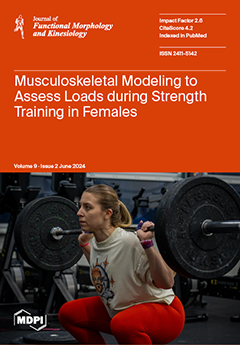The aim of our study was to investigate the relationship between sleep quality and functional indices, swimming distance and gender in adolescent competitive swimmers. Forty-eight adolescent swimmers (boys, n = 22, 15.7 ± 1.0 years and girls, n = 26, 15.1 ± 0.8 years) were included in our study. They were assessed for handgrip strength, respiratory muscle strength and pulmonary function, answered a Pittsburg Sleep Quality Index questionnaire (PSQI), and recorded their anthropometric and morphological characteristics and training load for the last four weeks. The results showed differences between swimming distance and chest circumference difference, between maximal inhalation and exhalation (Δchest) (
p = 0.033), PSQI score (
p < 0.001), and sleep quality domains for “cannot breathe comfortably” (
p = 0.037) and “have pain” (
p = 0.003). Binary logistic regression (chi-square = 37.457,
p = 0.001) showed that the variables Δchest (
p = 0.038, 95% CI: 1.05–6.07) and PSQI score (
p = 0.048, 95% CI: 0.1–1.07) remained independent predictors of the swim distance groups. Girls had a lower percentage of predicted values for the maximal inspiratory pressure (
p < 0.001), maximal expiratory pressure (
p = 0.027), forced expiratory volume within the first second (
p = 0.026), forced vital capacity (
p = 0.008) and sleep quality domains for “cough or snore loudly” (
p = 0.032) compared to boys. A regression analysis showed that the sleep quality score was explained by the six independent variables: respiratory muscle strength (t = 2.177, β = 0.164,
p = 0.035), Δchest (t = −2.353, β = −0.17,
p = 0.023), distance (t = −5.962, β = −0.475,
p < 0.001), total body water (t = −7.466, β = −0.687,
p < 0.001), lean body mass (t = −3.120, β = −0.434,
p = 0.003), and handgrip (t = 7.752, β = 1.136,
p < 0.001). Our findings demonstrate that sleep quality in adolescent swimmers is a multifactorial result of morphometric characteristics, strength and respiratory function.
Full article






